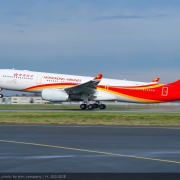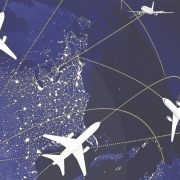In this edition of Morten Beyer & Agnew’s Insight Series, Anna Kopinski, mba’s Senior Associate of Asset Valuations, analyzes how the cargo market has fared in 2019, what aircraft are being used the most—and least—and how different metrics reveal divergent views on the state of the market. Later in this continuing series, she will assess the external factors which may influence the air cargo industry, such as US-China trade tensions.
Key Concepts:
- The air cargo market’s growth surge between 2017 and 2018 has started to wane.
- Quarterly fluctuations in global air cargo tonnage conceal the broad trends facing the industry.
- Claims that a deep decline in air freight traffic is imminent are not supported by the data.
Ups and Downs in the 2019 Air Cargo Market – Part I
A cursory read of the press would have us believe that the air cargo market has been in flux with a deep downward trend this year. Headlines have been shouting that the market is “faltering”, “sliding”, “declining”, and “flat-lining.” And indeed, the numbers look scary: compared to a peak in mid-2017, the growth rates have been trending downward:
 Source: CargoFacts, 2017-2019
Source: CargoFacts, 2017-2019
However, the reality is that 2017 and 2018 had unprecedented levels of growth in the market. When we take a closer look at those numbers, we begin to see that while growth has slowed and begun lagging, it has not really begun to decline in any appreciable fashion. In fact, according to OAG, while 1Q19 saw a rather noteworthy dip in total freight tons, the second and third quarters have seen more total freight tons than ever measured before, with nearly 8 million tons more freight flown year to date this year compared to the same time period in 2018. While it is impossible to encapsulate all trends by all carriers, we wanted to examine how the largers air freight operators were faring quarter over quarter, 2018 vs. 2019. As a cyclical industry, this provides a snapshot of market health. While the largest carrier, Emirates, saw declines in the second quarter of 2019, many carriers saw significant growth in 2Q19, both year over year and compared to the previous quarter. Looking at the dedicated air freight carriers, while there may not be growth, there is no great decline, either.  Source: OAG Analyser, August 2019
Source: OAG Analyser, August 2019
Finally, it is instructive to look at total freight tons carried by all air carriers over the quarters. Though the numbers fluctuate, the trend remains clearly growing.  Source: OAG Analyser, August 2019
Source: OAG Analyser, August 2019
In short, as tempting as it is to see this as the beginning of a deep decline in air freight traffic, the data does not substantiate such a negative outlook. Time will tell whether this is the market reaching critical mass, a market correction, or simply a plateau. Over the last few years, operators have taken aging passenger 737s, 767s, and 757s and converted them to freighters. In Part II of this series, we will investigate the equipment being utilized in the air cargo sector and how changes to fleet optimization methods impacts market capacity and growth. In Part III, we will revisit mba’s earlier position that a major hurdle for the freighter market would be the after-effect of trade tensions experienced between the U.S. and China in 2H 2018 and 1H 2019, which could severely derail the upward growth track that the market has enjoyed since 2014. Finally in Part IV, we will take a look back at all of the 2019 air cargo market, and try to ascertain whether delaying tariffs until after the holiday season had any meaningful effect on air freight traffic.
Download PDF



 Source: CargoFacts, 2017-2019
Source: CargoFacts, 2017-2019 Source: OAG Analyser, August 2019
Source: OAG Analyser, August 2019 Source: OAG Analyser, August 2019
Source: OAG Analyser, August 2019
 While the sale of interests in FFPs allowed airlines to access much-needed capital to stay afloat, they could no longer fully recognize the benefits of FFPs as a source of ancillary revenue. Realizing that this arrangement placed them at a significant competitive disadvantage, Air Canada signed a definitive agreement in November 2018 to buy back the Aeroplan loyalty program from AIMIA Inc. for $450 million in cash. Under the deal, Air Canada will also assume $1.9 billion of Aeroplan miles liability.
While the sale of interests in FFPs allowed airlines to access much-needed capital to stay afloat, they could no longer fully recognize the benefits of FFPs as a source of ancillary revenue. Realizing that this arrangement placed them at a significant competitive disadvantage, Air Canada signed a definitive agreement in November 2018 to buy back the Aeroplan loyalty program from AIMIA Inc. for $450 million in cash. Under the deal, Air Canada will also assume $1.9 billion of Aeroplan miles liability.